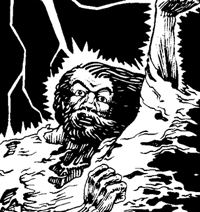Albeit, like displacer beasts and piercers, one whose name is just a rather bland description of what it does.
Thursday 20 May 2021
D&D Monsters: Rust Monsters
Tuesday 11 May 2021
D&D Monsters: Remorhaz(es)
 The remorhaz is another creature original to D&D, and one of the few such that is honoured with a proper name rather than a descriptive term. It's one of the more powerful creatures in the 1st edition that are described as simply animals, rather than intelligent beings. This is largely because it's so difficult to hurt, although it also has a bite that does more damage than that of most dragons. In later editions, it's toned down, although it remains quite fearsome.
The remorhaz is another creature original to D&D, and one of the few such that is honoured with a proper name rather than a descriptive term. It's one of the more powerful creatures in the 1st edition that are described as simply animals, rather than intelligent beings. This is largely because it's so difficult to hurt, although it also has a bite that does more damage than that of most dragons. In later editions, it's toned down, although it remains quite fearsome.1E
Tuesday 27 April 2021
D&D Monsters: Cloud and Storm Giants
 Cloud and storm giants are the most powerful of the standard races of giant in the D&D rules, the two final rungs on the ladder of increasing humanoid power. There doesn't seem to be any specific inspiration for them, although giants are sometimes associated with the sky in myths and legends. They are also the most intelligent, and the most inclined to be helpful, rather than hostile.
Cloud and storm giants are the most powerful of the standard races of giant in the D&D rules, the two final rungs on the ladder of increasing humanoid power. There doesn't seem to be any specific inspiration for them, although giants are sometimes associated with the sky in myths and legends. They are also the most intelligent, and the most inclined to be helpful, rather than hostile.1E
Tuesday 20 April 2021
D&D Monsters: Ettins
In any event, "ettin" is simply another, and older, word for "giant". In D&D, however, it specifically refers to a kind of two-headed giant; this is original to the game, but has been adopted by some other writers and computer game designers since.
Thursday 25 March 2021
D&D Monsters: Frost and Fire Giants
 Both frost and fire giants, as portrayed in D&D, are loosely based on the jötunn of Norse myth. In the original myths, this was a rather vague term referring to a race of mostly (but not always) gigantic beings originally created by the primordial being Ymir. Ymir himself was certainly gigantic, since the sky is said to be the inside of his blue-coloured skull, and he was also described in the Prose Edda as "ice cold". Thus, while frost giants aren't a specific thing in Norse myth, it's clear where the idea comes from. Fire giants, apparently also descended from Ymir in the original myth, are the inhabitants of the fiery realm of Muspelheim, led by Surtur, whose primary function in the myths is to destroy the world at the conclusion of Ragnarok.
Both frost and fire giants, as portrayed in D&D, are loosely based on the jötunn of Norse myth. In the original myths, this was a rather vague term referring to a race of mostly (but not always) gigantic beings originally created by the primordial being Ymir. Ymir himself was certainly gigantic, since the sky is said to be the inside of his blue-coloured skull, and he was also described in the Prose Edda as "ice cold". Thus, while frost giants aren't a specific thing in Norse myth, it's clear where the idea comes from. Fire giants, apparently also descended from Ymir in the original myth, are the inhabitants of the fiery realm of Muspelheim, led by Surtur, whose primary function in the myths is to destroy the world at the conclusion of Ragnarok.Both frost and fire giants appear in a range of fictional sources, of which perhaps the most obvious are the Mighty Thor comics. These predate D&D by over ten years, although it's likely that their appearance in the game is an independent creation from the same mythic origin, since they're quite clearly different from the comicbook versions. In D&D, they are the third and fourth rungs on the six-step ladder of increasing giant power and strength and are portrayed as more technologically advanced than the smaller hill and stone giants.
Wednesday 17 March 2021
D&D Monsters: Hill and Stone Giants
As is common where variants of the same idea for a monster exist in 1E, the six basic giants are arranged in a clear hierarchy of power, with each type having one extra hit dice, one extra point of strength, and delivering one extra die of damage than the one below it. Unlike some other creatures, while the details change, this progression of power remains the same in later editions.
Tuesday 23 February 2021
D&D Monsters: Bulettes

Incidentally, Gygax originally intended the word to be pronounced as "boo-lay", and official material from WoTC, and TSR before them, used to insist on this - and maybe still does. This raises a question, often seen in fantasy literature more generally, of "then why didn't you spell it that way?" In this case, I'll note that both the spelling and the supposed pronunciation appear vaguely French, which may be intentional - although, obviously, they don't match up with one another in that language either...


